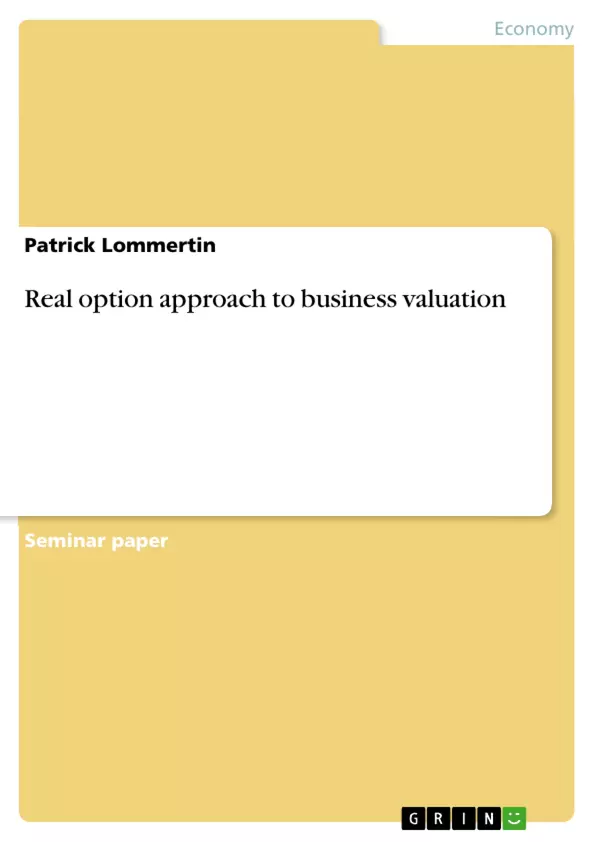There are various events to which a company valuation must be created. For the valuation of companies, various valuation methods are available. Most of these approaches are static calculation methods such as the discounted cash flow method. This method is one of the static corporate policies. The response to newly acquired information can not be taken into account and therefore lead to lower ratings from this approach and all other static approaches. This is especially true for young, innovative and dynamic company.
To better match the DCF method to the uncertain development of the future, various scenarios can be simulated with different parameters. Nevertheless, there is a reporting date and the mutual influence of the variables can not be adequately represented.
The real options approach, which was originally used only for the investment calculation can, also be applied to companies because the company valuation represents a special case of investment analysis. In the boom times of the new economy around the turn of the century was said to have the ROA that it would be a concept that justifies artificial-ly increased corporate values. For this period, the most of literature that deals with the real options approach comes from.
With the ROA no independent valuation method is presented, but an extension of the familiar discounted cash flow method. The crux of the extension is the evaluation of action flexibilities in the otherwise static method.
The aim of this study is to investigate the real options approach for its suitability as a business valuation method and to identify its strengths and weaknesses.
Table of Contents
- 1 Introduction
- 1.1 Problem and Objective
- 1.2 Procedure
- 2 Integrating the real options approach to business valuation
- 2.1 The real options approach
- 2.2 Classification of real options
- 2.3 Demarcation between real options and financial options
- 3 Of Real Option
- 3.1 Decision tree method
- 3.2 Rating with the binomial model
- 4, The real options approach to the review corporate practice
- 5 Views
Objectives and Key Themes
This study aims to explore the real options approach (ROA) as a business valuation method, identifying its strengths and weaknesses. The study delves into the concept of real options, their classification, and their application in a business valuation context.
- The suitability of the ROA as a valuation method
- The strengths and limitations of the ROA compared to traditional valuation methods
- The application of the ROA in practice, considering the challenges of identifying and evaluating real options
- The theoretical frameworks for evaluating real options, including the decision tree and binomial model
- The comparison of real options to financial options and the implications for valuation
Chapter Summaries
- Chapter 1: Introduction This chapter introduces the problem of valuing companies, particularly in the context of uncertainty and dynamic environments. It highlights the limitations of static valuation methods like the discounted cash flow method and introduces the real options approach as a more dynamic alternative.
- Chapter 2: Integrating the real options approach to business valuation This chapter explains the concept of real options, defining them as entrepreneurial leeway within investment projects. It explores different types of real options, including growth options, waiting options, and abandonment options. It then draws parallels between real options and financial options, examining their similarities and differences.
- Chapter 3: Of Real Option This chapter focuses on the evaluation of real options using specific methods. It discusses the decision tree method as a visual approach to analyzing options for action in a company. It also explores the binomial model, a numerical valuation method, and its advantages over the decision tree method.
- Chapter 4: The real options approach to the review corporate practice This chapter examines the challenges of implementing the ROA in practice. It discusses the difficulties in identifying and evaluating real options within a company, emphasizing the need for a comprehensive data base and the complexity of valuation methods. It also addresses the issue of competitive advantage when real options are publicly disclosed.
Keywords
The primary keywords and focus topics of this study include: real options approach (ROA), business valuation, discounted cash flow (DCF), decision tree method, binomial model, growth options, waiting options, abandonment options, corporate valuation, uncertainty, flexibility, investment analysis, strategic potentials, risk-neutral valuation, value-based management.
- Quote paper
- Patrick Lommertin (Author), 2013, Real option approach to business valuation, Munich, GRIN Verlag, https://www.grin.com/document/457705



